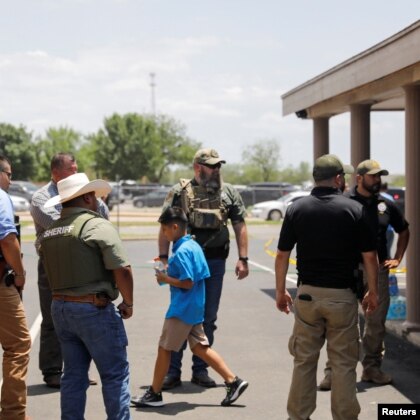

Children get on a school bus as law enforcement personnel guard the scene of a shooting near Robb Elementary School in Uvalde, Texas, U.S., May 24, 2022. (Reuters)
VOA Special Report
School shootings
Average age of a K-12 shooter is 18
Updated: June 1, 2022
Mass shootings (1966 - February 2020)
Nineteen children and two teachers were killed May 24, 2022, at an elementary school in Uvalde, Texas, about 135 kilometers west of San Antonio.
Texas Governor Greg Abbott said in a news conference that the 18-year-old gunman was believed to have been killed by responding police.
The mass shooting at the Robb Elementary School was the deadliest elementary school shooting in the United States since the killings in 2012 at Sandy Hook Elementary School in Newtown, Connecticut. Twenty-six people were killed in that attack, including 20 children.
The Texas shooting was also the second in less than two weeks involving an 18-year-old suspect. The gunman who allegedly shot and killed 10 Black people on May 14 at a Tops Friendly Market in Buffalo, New York, was also 18.
According to data on mass shooters compiled by The Violence Project, a nonprofit research center based in St. Paul, Minnesota, the average age of a K-12 school perpetrator is 18.
The center says shooters who carry out their crimes at elementary, middle and high schools share similar characteristics. Its research from 1966 to 2020 shows that most K-12 school shooters tend to be a white male student of the school who has an interest in guns, uses a high degree of planning for his act and uses multiple guns.
The gunman used an AR-15-style rifle, which he purchased legally.
About 15 minutes before the shootings, the gunman left a private message on Facebook, saying, “I’m going to shoot an elementary school.” As yet, there is no known motive for the shootings.
The first K-12 mass shooting of the modern era occurred in 1989 in the schoolyard at the Cleveland Elementary School in Stockton, California.
Five children — all of them Southeast Asian refugees — were killed. Thirty-two others were wounded. The attack led to California’s first assault weapons act.
After that violence, shootings took place at elementary, middle and high schools across the country every year for the next 10 years. Though they were not mass shootings — defined by the Congressional Research Service as four or more victims — and in several cases, resulted in no deaths, their impact on families and communities were everlasting.
In 1999, the shootings at Columbine High School in Littleton, Colorado, marked a turning point in school violence at K-12 schools. According to The Violence Project, the attack inspired an entire subculture of copycats, called “Columbiners,” and the city itself became synonymous with mass shootings.
In a column published in 2019 on a research and commentary website, Violence Project researchers Jillian Peterson and James Densely said since Columbine, six mass shootings and 40 active shooter incidents took place in K-12 schools in the United States. In 20 of the 46 shootings — including at Sandy Hook Elementary School in Newtown, Connecticut, in 2012, and Marjory Stoneman Douglas High School in Parkland, Florida, in 2019 — Columbine was the shooter’s obsession and inspiration.
School mass shooting locations Fatalities and school mass shootings (1966 - February 2020)
Circles scaled according to the number of fatalities.
Jillian Peterson, Ph.D., and James Densley, Ph.D., built the new database of mass shooters that they hope will inform future research and policy decisions about how to effectively prevent and respond to mass shootings.
For their study, they used the Congressional Research Service’s definition of a mass shooting:
“a multiple homicide incident in which four or more victims are murdered with firearms — not including the offender(s) — within one event, and at least some of the murders occurred in a public location or locations in close geographical proximity (e.g., a workplace, school, restaurant, or other public settings), and the murders are not attributable to any other underlying criminal activity or commonplace circumstance (armed robbery, criminal competition, insurance fraud, argument, or romantic triangle).”
About the data
All shooters have either been charged, convicted or killed at the scene.
The team collected more than 100 pieces of information on each of 172 mass shooters, resulting in The Violence Project Database of Mass Shootings in the United States, 1966 - February 2020.
They compiled details on hundreds of factors, including age, race, gender, nationality, sexual orientation, religion, education, relationship status, number of children, employment type and status, military service and branch, criminal, violence and abuse history, gang and terrorist affiliation, bullying, home environment and trauma.
What emerged were fleshed-out profiles and motivations of individual shooters, whose crimes can potentially influence current and future policy and prevention.
School shootings (1966 - February 2020)
While there is no single profile of a mass shooter, there are several similar characteristics of shooters who carry out their crime at elementary, middle and high schools.
According to The Violence Project, the K-12 school shooter tends to be a white male student of the school with a history of trauma, and is suicidal. He has an interest in guns and uses a high degree of planning for his act. He leaks his plans ahead of time in the form of a video or a manifesto, and uses multiple guns that he stole from a family member.
Sixty-nine percent of K-12 shooters experienced severe childhood trauma, which includes parental suicide, physical or sexual abuse, neglect, domestic violence and/or severe bullying. Sixty-two percent had a criminal record, and 69% had mental health concerns. Almost all K-12 shooters were in crisis prior to the shooting (85%), marked by bullying or suspension from school.
The average age of a K-12 perpetrator was 18.